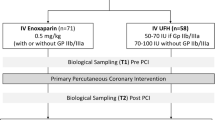Abstract
Midkine (MK) is a heparin-binding growth factor, whose role as a biomarker of coronary artery disease, myocardial ischaemia and necrosis has not been well measured. This study quantified serial MK levels in patients undergoing coronary angiography (CA) and identified factors associated with MK. In this single-centre, parallel cohort study, forty patients undergoing CA had arterial samples collected prior, 10 and 20 min after heparin administration. Four groups were examined: 1—stable coronary artery disease (CAD) without percutaneous coronary intervention (PCI); 2—stable CAD for elective PCI; 3—non-ST elevation myocardial infarction (NSTEMI) with or without PCI; 4—ST elevation myocardial infarction (STEMI) with primary PCI. Groups 1, 2 and 4 were heparin naïve, allowing assessment of the effects of myocardial necrosis between baseline levels; group 3 had received low-molecular-weight heparin. MK levels were analysed by ELISA. Median MK at baseline did not differ between groups, demonstrating that myocardial ischaemia or necrosis does not affect MK levels. Heparin administration had an immediate effect on median MK at 10 min, showing an average 500-fold increase that is dose-dependent (R2 = 0.35, p = 0.001). Median MK levels remained elevated at 20 min following heparin administration. Multivariate analysis showed that the estimated glomerular filtration rate (eGFR) was the only predictor of elevated baseline MK (p = 0.02). Baseline MK did not correlate with high-sensitivity troponin-I (HsTnI) taken just before CA (p = 0.97), or peak HsTnI during admission (p = 0.74). MK is not a reliable marker of myocardial ischaemia or necrosis. MK increased significantly in all patients following heparin administration in a dose-dependent manner.

Similar content being viewed by others
References
Woulfe, K. C., Sucharov, C. C. (2017). Midkine’s role in cardiac pathology. Journal of Cardiovascular Development and Disease, 4(3).
Kadomatsu, K., Bencsik, P., Gorbe, A., Csonka, C., Sakamoto, K., Kishida, S., et al. (2014). Therapeutic potential of midkine in cardiovascular disease. British Journal of Pharmacology, 171(4), 936–944.
Malyszko, J., Bachorzewska-Gajewska, H., Koc-Zorawska, E., Malyszko, J. S., Kobus, G., & Dobrzycki, S. (2015). Midkine: A novel and early biomarker of contrast-induced acute kidney injury in patients undergoing percutaneous coronary interventions. BioMed Research International, 2015, 879509.
Beck, H. C., Jensen, L. O., Gils, C., Ilondo, A. M. M., Frydland, M., Hassager, C., et al. (2018). Proteomic discovery and validation of the confounding effect of heparin administration on the analysis of candidate cardiovascular biomarkers. Clinical Chemistry, 64(10), 1474–1484.
Ibrahim, N. E., Januzzi Jr., J. L., Magaret, C. A., Gaggin, H. K., Rhyne, R. F., Gandhi, P. U., et al. (2017). A clinical and biomarker scoring system to predict the presence of obstructive coronary artery disease. Journal of the American College of Cardiology, 69(9), 1147–1156.
Acknowledgements
The authors would like to thank the staff of John Hunter Hospital Cardiac Catheterisation Laboratory.
Funding
This is an investigator-initiated study with funding from Cellmid Ltd.
Author information
Authors and Affiliations
Corresponding author
Ethics declarations
Conflict of Interest
The authors declare that they have no conflict of interest.
Ethics Approval
All procedures performed in studies involving human participants were in accordance with the ethical standards of the institutional and state research committee (HNEHREC reference no. 12/06/20/5.04, NSWHREC reference no. LNR/12/HNE/196, NSW SSA reference no. LNRSSA/12/HNE/197) and with the 1964 Helsinki declaration and its later amendments or comparable ethical standards. Informed consent was obtained from all patients for being included in the study. No animal studies were carried out by the authors for this article.
Additional information
Associate Editor Craig Stolen oversaw the review of this article
Publisher’s Note
Springer Nature remains neutral with regard to jurisdictional claims in published maps and institutional affiliations.
Rights and permissions
About this article
Cite this article
Sugito, S., Hall, S., Al-Omary, M.S. et al. Heparin Administration, but Not Myocardial Ischemia or Necrosis, Leads to Midkine Elevation. J. of Cardiovasc. Trans. Res. 13, 741–743 (2020). https://doi.org/10.1007/s12265-020-09955-w
Received:
Accepted:
Published:
Issue Date:
DOI: https://doi.org/10.1007/s12265-020-09955-w




